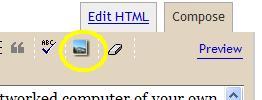Podcasting IS ready for the masses, contrary to the
Wall Street Journal's first look into the subject by Mossberg (2005). Though misinformation about easy to use tools might appear to slow down development, new podcasts already arrive faster than the
iTunes Podcast Directory team can screen and add them to this free online library. In fact there is no homogeneous mass of users, rather a very wide range of experience. There is a gradient from very easy to professional resources that provides a great set of stepping stones for all ranges of those interested making their own podcasts.
The most elemental approach is to let someone else do it. For those who never want to touch the technology but have something to say or share, entrepreneurs are opening businesses that provide drop-in services or bring a portable studio to your home or office. One example is
Palegroove Studios, found at
http://www.palegroove.com/. They will not only produce the podcast, but see to it that it appears online. Will we really see a proliferation of podcast stores and delivery cars that say Podcast on top instead of Pizza? Will radio stations which have all the necessary expertise and technology create their own operations to compete, perhaps expanding their audience by creating podcast shows that play some of what they help the community produce? Leave your thoughts at the comment link below.
Beginners willing to touch a computer just need what one might call blog simple. Blogger.com has a bullet-proof approach which requires but a cell phone, and the capacity to discover
Blogger Help's add-on features which lead one to audio account set up at
http://audioblogger.com. I have been using this service for over a year. Dial one number, enter the phone number selected as your password, and everything recorded up to five minutes or until the pound key is pressed on the phone automatically becomes an mp3 file. The designated blog site automatically creates a post, and shows a play icon in the posting to visitors. "Look Ma, no hands!" Presto an audio blog that any user of the Web can play. Without visiting your computer and running an application, the audio blog is available, though returning later to add comments, pictures or notations can add much to the message. For example, see my
post with podcast, text and picture.
But its not quite a podcast, capable of RSS syndicating with blog news readers, and synchronizing to download with
mobile mp3 players. To do this, change the blog site's feed to Feedburner (as is the case with this blog site), putting the Feedburner link in a column on the page. Then, turn on linking and copy the HTML address location of the audio file into the link field. That's it.
More advanced users of Blogger.com have additional options. For those with HTML editing experience, the code for the icon can be pointed to any audio file stored in a web account anywhere. That is, any podcast uploaded to a personal web account can be pointed to (linked) from your blog site.
More features add complexity but also add appeal and nuance. Professional standards for audio add music backgrounds, bumpers, and other devices to monologue or conversation or add lead-in dialog to music. Each layer of music can be thought of as a track. Software can be used to do what a radio or music studio can do, bring different layers together, merge them into one file, and post them online. This "studio" software can be found as desktop applications or web-based applications. Curiously, both of them are called GarageBand.
The web site called GarageBand
http://www.garageband.com/podcast offers the next easiest step to creating a podcast. It plans to provide phone call-in of audio as does Blogger.com but will go one step further and make the call toll-free. In the meantime, it currently provides features for uploading audio files created elsewhere directly to Podcast Studio, a Web-based tool used to record, mix with already created songs found at the site and publish a podcast. They currently also offer over 40,000 music podcasts for great listening and downloading. Watching a short
movie of a podcast production (click the links under stream or download) in which microphones and desktop computer applications are used instead of cell phones may provide better understanding of the process and concept instead of just reading about it.
More outfits are waiting in the wings with podcast creation tools, such as
Odeo, a new
hot start-up, with co-founder Evan Williams who was also co-founder of Pyra, bought by Google and turned into Blogger.com. They too are promising soon to be ready to record, mix and publish with phone-in and audio file upload services. Would you leave a comment if you know of more competitors in this area?
At a higher level of skills, the Sound Recorder application that comes from with the Windows operating system can provide basic recording but in a format that will still need conversion and compression for web play.The application shipping with the Macintosh computer called GarageBand also provides a rich set of desktop tools for composing music, recording and mixing tracks. (The name is unrelated to the GarageBand web site, creating some confusion in the marketplace.) GarageBand offers a rich set of tools and sound loops for actually creating a song itself. Their web site provides a walk-through of the
steps involved for podcasting, whether a created song or dialog. An inexpensive cross-platform tool can be found in Quicktime 7.0 which provides audio recording and conversion to the necessary formats for web play. Competitors like
ePodcast Creator and Producer will work cross-platform and simplify the process.
Higher quality audio requires more professional equipment and an even higher skill level. Information on podcast setups with real microphones and other tools are not hard to find, e.g.: $100 U.S.
Roadhouse design; or $200 U.S.
BSW's podcast packages. More sophisticated software for multi-track audio is readily available, including:
SoundTrack Pro;
Audacity; and
ProTools among many. See a Google search for "
podcast setup" to sift for more studio combinations.
The intense focus on podcasting may be overlooking an unintended but positive long term benefit,
podcasting entrepreneurship. At the highest level are professional recording studios such as those long employed in the creation of records and music CDs by orchestras, bands and others. As quality counts, the expanding horde of podcasters will generate a growing number interested in paying for audio recording done at the highest level. As use of podcasts grows, advertisers will provide commercials and sponsorships to go with the podcasts. The very highest interest and quality podcasts will be able to require a subscription.
Where to start? Even given their five minute limit per recording, I find Blogger.com's cell phone arrangement for podcasting to be current champion of lowest cost and least effort. There is no limit to the number of 5 minute postings that can be made. Whatever your choice, get busy and plan your podcasts.






